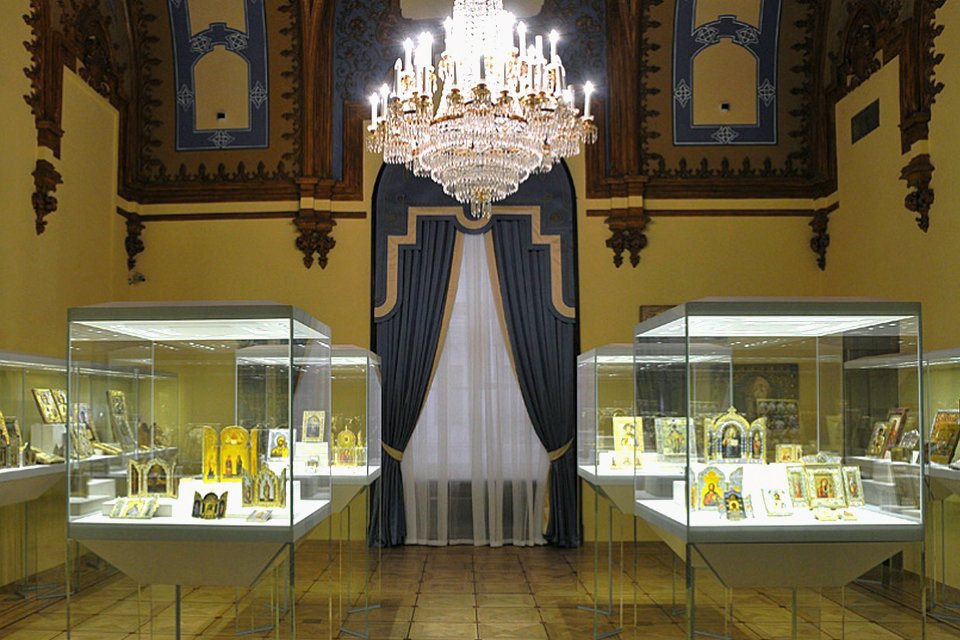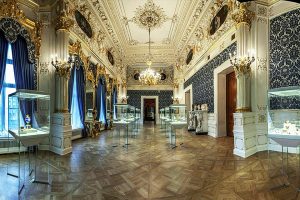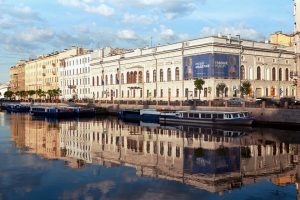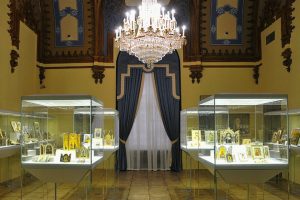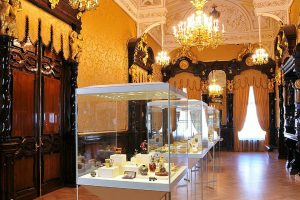Palace of the Naryshkins-Shuvalovs is a unique historical monument to the reign and personal life of Alexander III and Nicholas II. Easter jewelry is located in the blue living room of the palace. Other halls also display collections of 19th-century Russian porcelain, enamels, stone-cutting products, Russian icons, paintings, silver, precious utensils and memorial items.
The White Column Hall
In 1799, Maria Naryshkina and her husband, Dmitri Lvovich Naryshkin, filled it with spectacular art and marble sculptures, as well as antiquities including gems, coins, and weapons. The palace became the center of the Saint Petersburg society, and its grand ballroom — also known as the Alexandrovsky or White Column Hall — played host to society balls of up to 1,000 people. The most famous ball was held on 1834 to celebrate the 16th birthday of the future Emperor Alexander II.
During the Siege of Leningrad, shelling and bombing heavily damaged the palace. On 14 September 1941, a bomb completely destroyed the courtyard wing. An incendiary bomb caused even greater damage when it went through the roof into the attic above the Alexander Hall, starting a devastating fire that caused the roof to collapse.
Exhibition Room: Stone carvings by the House of Fabergé and their contemporaries.
Russian paintings from the 19th century. The Exhibition Room, known by the first Shuvalovs as the Great Study, once house the family’s personal museum. Today, the Exhibition Room is home to stone carvings by Fabergé and paintings by nineteenth century Russian artists.
Gothic Hall: Russian icons.
The Gothic Hall, once the study of Count Pyotr Shuvalov, features a collection of Russian icons from the 16th-20th centuries, most of which are clad in frames and covers of precious metals made by famous jewelers from Moscow and St. Petersburg.
Upper Dining Room: Turn of the 20th Century Russian and European paintings.
On display in the Upper Dining Room are paintings by Russian and French impressionists and neoimpressionists from the end of the 19th-beginning of the 20th centuries. Special attention should be given to the works of August Renoir and the great Russian impressionist Konstantin Korovin. A prominent piece is the Palace Vase, painted by Fyodor Krasovsky.
Faberge Museum in St. Petersburg
The Faberge Museum is a private museum in St. Petersburg, located in the Naryshkin-Shuvalov Palace. It has an unparalleled collection of Russian jewelry and arts and crafts of the 19th – 20th centuries. The most valuable and famous objects in the museum’s collection are 9 imperial Easter eggs created by the company of Carl Gustav Faberge. The museum’s collection, including the first and last of the imperial eggs.
Faberge Museum’s collection has more than 4,000 items, among which, in addition to the famous Easter eggs, are fantasy items, silverware, interior and religious items, as well as jewelry created by Faberge. Also in the museum’s collection are works by contemporaries and rivals of Faberge — masters of jewelry I. Sazikov, P. Ovchinnikov, F. Rückert, I. Khlebnikov and many others. The exhibition hall of the museum presents paintings by I. Aivazovsky, K. Makovsky, K. Bryullov, V. Ammon, V. Polenov, G. Semiradsky and female portraits of A. Kharlamov. In the Upper Buffet Palace of the Naryshkin-Shuvalovs, the works of P.O. Renoir, Louis Walt, Henri Martin, K. Korovin and K. Gorbatov are posted. A collection of Russian icons is exhibited in the Gothic hall of the palace. The Faberge Museum in St. Petersburg is rightfully proud ofCarl Gustav Faberge in the period from 1885 to 1916.
The official opening ceremony of the first privately owned Fabergé Museum in Russia took place on November 19, 2013, in the Shuvalov Palace in St. Petersburg. The founding organization of the museum is the Link of Times cultural and historical foundation, which was established in 2004 with the aim of repatriating items of cultural significance to Russia.
The idea of creating a series of museums in Russia dedicated to the works of the great jeweler Carl Fabergé first came to the Link of Times in 2004. In that year, The Link of Times Foundation purchased a one-of-a-kind collection of Fabergé works which had been collected by Malcolm Forbes. Since then, the foundation has been collecting Russian works of decorative and fine art and has amassed more than 4,000 items today. In terms of its size, diversity, and the quality of its pieces, many of which belonged to the royal family and other members of the royal courts of Europe, the collection is without a doubt one of the best in the world.
The exclusivity of the Fabergé collection acquired by the Link of Times foundation also comes from the fact that this collection represents all of the areas the House of Faberge specialized in: objects of fantasy of all kinds, jewelry, small goods, silverware, and interior and religious objects. In addition to works by Fabergé, the collection also includes works by his contemporaries, including famous Russian jewelers and silversmiths such as Sazikov, Ovchinnikov, Khlebnikov, Rückert and many others.
